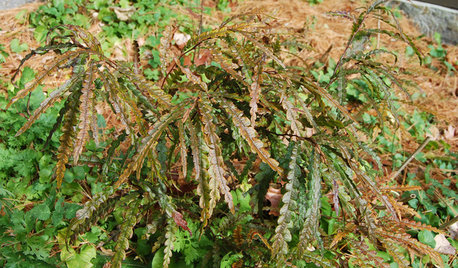Shortleaf pine
spruceman
15 years ago
Related Stories

GARDENING GUIDESGreat Design Plant: Comptonia Peregrina
Though not a fern, sweet fern sure smells sweet and thrives in tough spots where many shrubs and ferns cannot
Full StoryIs anyone growing this kind of pine in anywhere in the more northerly pats of its range--Virginia, WV, PA, OH, or more interior high elevation areas of NC, etc.? It is a "southern hard pine," but grows further north than the others.
Here in VA I don't see it planted, and nurseries like Musser Forests, Carino, etc. don't offer it. But nearby where I live here near Winchester, VA, I find it growing as scattered individuals mixed in with chestnut oak and hickory on some of the mountain tops.
I think it is an interesting and beautiful tree in the more northerly parts of its range and I would like to grow it. But I am reluctant to buy seedlings from more southerly sources. As it happens, yesterday I found a seedling growing on a road bank in a semi-active housing development nearby, and will look for an oportunity to dig it up this March. But that gives me just one. I have been looking for seedlings of this tree for some time, and this is the first I have found.
Anyway, if anyone knows anything about transplanting and growing this kind of pine, I am interested. I read something that makes me think it may be difficult to dig and transplant, but I may be reading too much into what I read.
--Spruce






MissSherry
pineresin
Related Discussions
what are the common scrubby pines in MD?
Q
Ozark pine verification
Q
Looking for native pine tree source
Q
Shortleaf pine cones at only 4 years?
Q
alabamatreehugger 8b SW Alabama
MissSherry
lkz5ia
sprucemanOriginal Author
jqpublic
alabamatreehugger 8b SW Alabama
j0nd03
wisconsitom
scotjute Z8
arktrees
bengz6westmd
sprucemanOriginal Author
bengz6westmd
jqpublic
crazyoldgoose
bengz6westmd
scotjute Z8
sprucemanOriginal Author